Women Freemasons in Cuba
By Alfredo Fernandez Rodriguez, photos: Irina Echarry
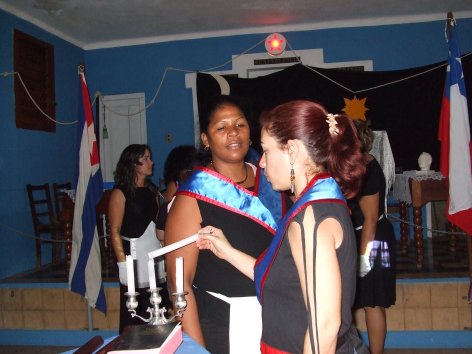
HAVANA TIMES, April 6 — Currently I’m a professor teaching the history of philosophy at the University of Havana. During a previous course, while I was getting signatures from my students for their exams, something unexpected occurred: When signing her form a coed added three dots, which is what identifies those who are Freemasons. I was thinking this was no more than the student’s bad sense of humor, but when I asked her about it she responded, “But prof, I’m a Mason.”
At the time I didn’t believe her because I’d always heard that women were prohibited from practicing Masonry; the most they can be are “Hijas de la Acacia,” an association of women that to me are a sort of women’s Masonry.
The student continued by telling me that female Masons perform rites almost the same way as men, that the society had come to Cuba through Chilean colleagues, and that there were now two lodges on the island – one in Havana and the other in Pinar del Rio.
Prior to this, the closest thing I’d ever heard connecting women with Masonry was an incident in France —still unconfirmed by historiography— involving Louise Michel (1830-1905), an anarchist and animal rights advocate who was buried with Freemason honors upon her death in Marseilles.
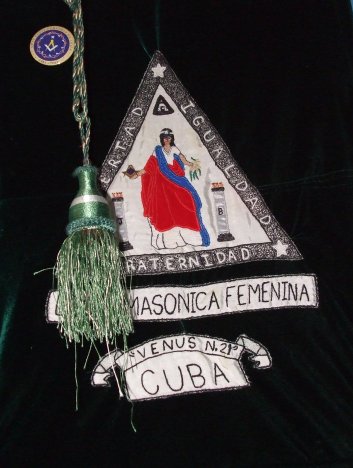
Later, when searching in Google, I was even more astonished to find that women such as Flora Tristan (1803-1844) and Helena P. Blavatsky (1831-1891) were also Masons: the first was a French activist for women’s emancipation, workers rights and against the death penalty; and the second a Russian-American who was a founder of the Theosophical Society. Upon Blavatsky’s death, Jose Marti dedicated a short writing to her.
In my opinion, a fellowship association such as the Cuban women’s Masonry can serve as a subtle but effective blow against national machismo.
With that in mind, this interview was conducted with Leticia Cora Guerra, Master Mason; and Aryan Lisset Garcia, Junior Warden; both of the Venus No. 23 Lodge.
Leticia, when I reviewed articles I found on Google concerning women’s Masonry in Cuba, it became obvious that a certain figure in Cuban men’s Masonry, Manuel Collara Vento, the Grand Master of the Grand Lodge of Cuba from 2000 to 2003, is recognized as a “strong defender of the admission of women into this institution.” However, when I asked other male Freemasons about women’s inclusion in Masonry, a large percentage believed it was not a place for women. So, what’s been the reception by your colleagues of the opposite sex to Cuban women’s Masonry?
Before answering the question I should point out to you that I’m aware of the excellent work undertaken by male Cuban Masonry over its 150 years of existence, given that it’s the “daughter of the United Grand Lodge of England (UGLE),” which is the equivalent to being governed by the Anderson Constitution, the early fundamental law of January 17, 1723.
Of course with that foundation (according to its third heading, paragraph four), it speaks of “harboring in its bosom those men who are good and loyal, free from birth, of a mature and reasonable age and of good reputation; with it being forbidden to admit into the Masonry, slaves, women and immoral men whose behavior would be the cause of scandal.”
As one can see, we were generically excluded. But in relation to the female sex, we have to ask what was the historical and social context in which this constitution emerged? It’s enough to point out that at the time we weren’t considered human, only objects without the ability to reason. We were not individuals; our identity was defined by our belonging to a father or a husband. Today we have to ask ourselves: What does it now mean for a Masonic entity belonging to the United Grand Lodge of England, in this case the Cuban male Masonry, to recognize us as women Masons?
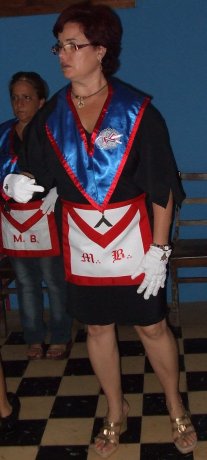
It means losing their “regularity” [a constitutional mechanism whereby Grand Lodges recognize one another]. The concepts of Regular and Irregular that are presently in use are obsolete in my modest assessment, and fortunately in that of thousands of brothers and sisters in Cuba and around the world. Now, in the middle of 21st century, regularity goes beyond gender and it’s apt for me to point out that the two Cuban women’s Masonic lodges —Venus No. 23 and Victoria No. 24— were legally incorporated as lodges in rigorously-carried-out ceremonies within the practice of the Rito Escocés Antigua y Aceptada (Early and Accepted Scottish Rite or R.E.A.A.) with Carta Patente of the Grand Women’s Lodge of Chile, a Masonic entity recognized worldwide.
Alfredo, I have to say I’m delighted, as are thousands and sisters and brothers. Not all Freemasons have remained stuck in time. Concretely, there are wonderful people with revolutionary ideas in Cuba who shine from their own inner light. Because of this, I can divide the reception that women’s Masonry in our country has received by male Freemason brothers into three groups.
Before this, though, I should say it’s clear that we’re free thinkers and that we’re also free to discern and say what we think, but all of that must always be done with tact, and above all with respect, because many of us are mothers, wives and the daughters of freemasons.
In terms of the three groups…
Group One: These are the ones who don’t accept us and therefore don’t recognize us, with the majority experiencing sharp internal debates in their groups with respect to us, always guarding a marked distance from us. Along with them there’s an even more disrespectful, offensive and completely intolerant minority, sadly distant from the essential values that a true Mason must have.
Group Two: This is made up of those who are skeptical and fearful of openly expressing sympathy toward us, but who don’t fail to offer their consent —though they do so with great discretion— each time they have the opportunity.
Group Three: These are the men who openly welcome us with love and recognize us any time and place as their “dear sisters.” They don’t simply deny evolution, neither of women nor of the Order, tying it to the insurmountable limits of a dead past. These are dear brothers who see us beyond differences of gender, because they only see human beings in women’s bodies. They see that we’re making efforts daily to become more cultured and to glorify our work. They see that we are women who, just like them, found in Masonry a different way of facing life. They recognize that these are women who strengthen their homes and their social environment with the daily cultivation of values.
I want to emphasize that each and every one of us women Masons do indeed see ourselves as equals. We recognize all of our brothers, respecting their ideas, concepts, conservatism and limits, hoping that on one not-too-distant day we can share together, beyond the boundaries, celebrating the triumph of the dynamic force that moves today’s progressive Masonry beyond the static tendencies of the past.
Lisset, if the education of women in western culture is determined “inside the home,” let’s say by attending to the husband, educating the children and remaining in the house for the greatest amount of time possible, then it must not be easy being a female Mason?
There’s a famous sociological study on gender called The Glass Ceiling. It gets its name from the fact that there’s a high and invisible surface hovering above the careers of working women and is difficult to break through; it prevents them from advancing. Its invisible character stems from the fact that there exist neither laws, nor established social mechanisms nor visible codes that impose similar limitations on women; rather, they are built on the basis of other features that are difficult to detect precisely because of their invisibility.
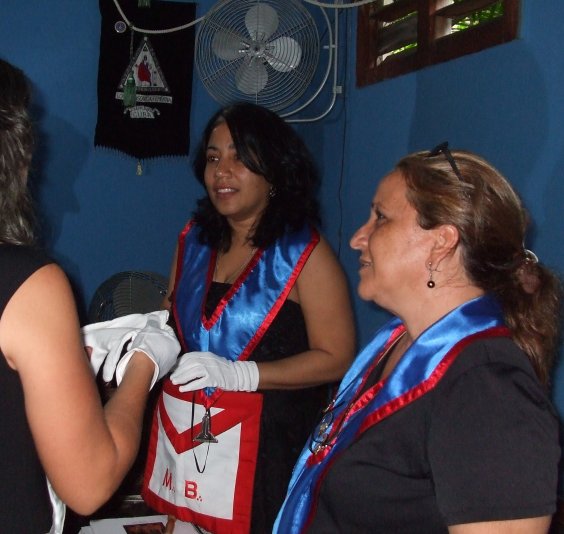
This ceiling is transparent and imaginary, but it exists as a constraint against all women who attempt to develop themselves outside of that context you call “inside the home.” I’m of the opinion that members of the family should be conscious that the responsibilities for the home fall on each member; only if it is viewed like this will it be possible to build a true family.
Women Masons seek to remedy these wrongs by educating women to be strong, enterprising and especially capable in any circumstance and in facing whatever task. However, this must be done without abandoning her place in the home, helping her partner to build a better family and a better society based on the values advocated and defended by Masonry, which are in fact universal values.
So we work on the basis of valuing the family, respect and the recognition of women, because we believe these are the measures needed to increase their self-esteem and responsibility.
Leticia, in their iconography, the men’s lodges exhibit paintings of Cuban patriots who were Freemasons. What are the paintings exhibited in the lodges of female Cuban Masons? Do these have portraits of Cuban Freemason patriots or those of women Masons from other countries?
Unfortunately, Cuban female Masonry today still doesn’t have its own temples. We are two itinerant lodges that meet with all the rigor of consecration, both ceremonial and ritual. Women participate in educational chambers at the homes of sister Masons as well as in the facility at the Orden Caballero de la Luz, where each time we have to set up and take down our temple. This makes it difficult for us to decorate our facilities with paintings and portraits of Cuban patriots who were Freemasons.
Nevertheless we have always envisioned that when we have our own temple we would adorn the hall with the artwork by Cuban and internationally recognized female artists, such as Amelia Pelaez, Flora Fong; Zaida del Rio, with whom we’ve already had contact; and the Spanish painter Maria de los Remedios Varo. Of course both of our lodges are also open to including art by our dear brothers, as well as pieces by male artists who want to donate a little bit of their work to us.
We guard and honor images of our dear Freemason brothers of Cuba and of all the Americas —such as Marti and Juarez, to cite only two examples— as well as memorable pictures of female Masons from this and other centuries. Many of these paintings and portraits were exhibited as posters in the Camara Docente de Verano (Summer Educational Assembly) that we held in August 2009 at the Fernando Ortiz Foundation. At that event, we didn’t solely involve and exhibit female Cuban Masons, we also enjoyed the presence of our male brothers, friends and relatives.
It is important to point out that though the patriot Freemason brethren are not physically present, their legacy is maintained in their constant presence in our workshops. For example, every January 28 we perform a special ritual dedicated to our dear brother Jose Marti, and during National Culture week we pay tribute to the Cuban flag, which is Masonic in its symbolic entirety; moreover, all of the Freemason patriots who participated in its making were assisted by valiant women.
Lisset, on the Internet there’s a picture of some of the first services of women Masons in Cuba. From this photo I’m curious that while presently more than 50 percent of the Cuban population is black or mestizo, at least 95 percent of the female Cuban Masons present in that session were white women or appear to be. Obviously I know it’s not among your aims to segregate any woman owing to their color because that would be violating one of the basic principles of fraternity, equality. But just the same, let me ask you: Will black Cuban women have to deal with the same obstacles in relation to Masonry that they face daily in integrating other institutions?
Look Alfredo, segregation in Cuba today is a burning issue. Recently the issue was dealt with openly on Cuban television. Diverse points of views were presented, some less direct than others but generally all of them were about the acceptance of the fact that there is a problem. In fact, in many sectors there exists the problem of racial discrimination as sharp as the gender problem.
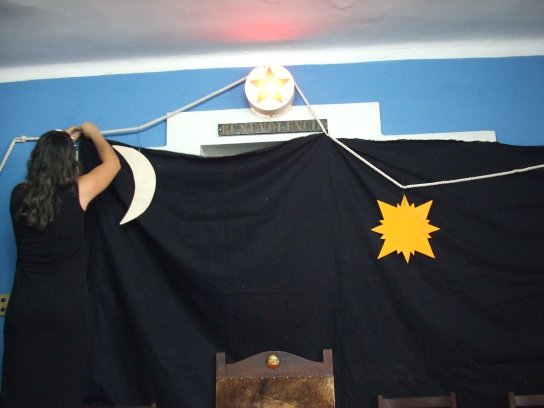
Presently we’re working to eradicate every situation that morally, physically, spiritually and intellectually attacks our women. It would not be wise or ethical to fall into a dichotomy in which we begin to do one thing and advocate another.
All institutions are subject to human errors because they’re made up of people. When bad things occur we cannot place the blame on anybody other than ourselves. As long as we continue doing what’s right so that we avoid any racial obstacle or any other type of hindrance as established under our current norms, which don’t differ much from the general ones.
You’ll note that we are an example of racial integration in our Pinar del Rio lodge. There, Victoria No. 24 lodge is beautifully adorned with black women. In fact the current Grand Master of Pinar del Rio is black, as is part of the leadership of our lodge, Venus No. 23. There are mestizo women in the lodge I’m in.
So we would never even think of promoting something as vile and contemptible as preventing the membership of a dear sister in our temple because of the color of her skin. Perhaps there exist examples in other places where this is done, but that isn’t the situation in our case, and I believe that has been one of the reasons —despite the obstacles in our road— that women continue struggling for and supporting our goal. In women’s Masonry in Cuba there’s definitively a place for respect and recognition for all women.
Leticia, so when will the “Grand Masonic Temple of Women” be built in Cuba?
We’re not desperate. Right now we’re in a stage of consolidation, growth and learning. We are in line with an education and activities timetable being coordinated with our Masonic sponsor, The Grand Women’s Lodge of Chile, according to which we should constitute ourselves as a Grand Lodge between 2010 and 2011.
Nevertheless, we’re advancing in short but firm steps. It’s not our goal to grow in quantity, but in quality. To legally constitute ourselves as a Grand Lodge, we must have three lodges according to Law 54/85, the Associations Law, and its concordant 1986 Regulation. Currently in Cuba there exist some 60 female Masons distributed among the three symbolic “degrees of Craft” and the two lodges (Victoria No. 24 in the valleys of Pinar del Rio and Venus No. 23 in the city of Havana). There are also sisters in the surrounding Havana province, the municipalities of Bejucal and Artemisa, as well as “Promotion Groups” existing in the cities of Cienfuegos and Santiago de Cuba and some about to form in Holguin and Bayamo, in addition to several candidates now in the process of joining.
What is now an unstoppable fact are the stories that female Cuban Masons are writing today. In a near future these will be the pillars that sustain the Grand Women’s Masonic Lodge of Cuba.
Lisset, in your way of seeing things, what are the most important challenges facing Cuban women today?
You don’t have to be much of an observer to realize that Cuban women are self-sacrificing and hard working, with their main challenges being the combining of home and family duties with other activities that allow them to expand their intellectual and spiritual capacity, such as work or study, and in our case Masonry.
It’s known that in their great majority, women are the ones who carry the weight of the family. The education of children falls mainly on their shoulders, almost always on the basis of appropriate values, though today many have gotten lost.
But the main challenge that woman today must face is a lack of consciousness in general terms, individuals unaware of their true role and there is a lack of consciousness on the part of many that the same things exists inside and outside of the home. They don’t admit that women are also part of society and that they’re entitled to be recognized in it as vital elements in the formation and transformation of that society. We are the other half of the universe and rightfully so. We are the mothers, sisters and wives of that half that is at times harsh and disrespectful toward women.
Do you believe women’s Masonry in Cuba will end up achieving the same success as male Masonry; and if not, what might prevent it from accomplishing that?
Alfredo, being a female Mason is in no way a category of banal recognition that distinguishes us, but above all it is a duty of commitment, assumed first with ourselves and then before our society, before the Grant Women’s Lodge of Chile, which trusted a group of Cuban women and deposited the Masonic light in us, before Latin America, the world and basically before the Masonic people.
We are still very small. April 1 will mark barely two years since our creation. I think it’s absurd to compare us to the 150-year existence of Cuban men’s Masonry. Two years ago our Chilean sisters put the necessary tools in our hands for us to become better women, free thinkers, lovers of work as it dignifies us as human beings.
We are women who day after day when getting up make each good action our personal legend for everything that surrounds us. We’re not perfect, but beginning with our initiations we’re made aware that we are perfectible and this makes us strong and unites us.
Success will depend solely and exclusively on not giving up for an instant. It will depend on the determination that moved each and every one of us to be a part of Universal Masonry, which is transforming us into better human beings. We women Cubans were, are and will always be eager to be a fundamental link in the idea and materialization that a better world is possible and that nothing and no one will prevent that.
Thank you.

Freemasonry are for the unintelligent, have met some, they are not bright!
I praise the masonic ladies of cuba.
I am a single parent father,raising my 12 yr old daughter.We are currently trying to become citizens of cuba.If we are sucseful,i will certainly do anything in my power to have me daughter become a mason once she is of age.As i myself am a mason here in canada.
You are trend setters for the world,excellent work ladies.
Happy that women in Latin America are makie huge progressive in Freemasonry
I am Happy to learn Masonic activities exist in Cuba .-
I applaud these sister’s for stepping out of the darkness! In forgotten history there are many women who knocked at the door of the temple.Elizabeth St Lege, Isabella Scoon,Catherine Sweet,Mme de Xaintrailles ,Countess Hadik Barkoczy,Maria Desraimes.There were numerous societies in France in the early to mid-eighteenth century which admitted men and women equally, and which had secret ceremonies and one of them were and are the Rosicrucians.The ancient mystics of every land initiated the female polarity.The Manichees were divided into initiated Elect and ordinary members called Hearers. The Cathari”Cathars” were divided into Perfecti and believers or Credentes and they initiated women. The Cathar initiation ceremony seems to be derived from the Manichaean ritual. Both distinguished between the Gnosis (knowledge) of the Initiate and the Pistis (belief) of the ordinary believer. The earliest signs
of something that can be clearly identified as Catharism appear in Cologne in 1143 and
then in Italy in 1179. If you what to go back farther we can add Queen Hatshepsut(1479 – 1457 BC) and Queen Tiye(18th Dynasty Egypt) to name a few. They understood the Hidden Mysteries of Integrating the masculine and feminine energies and coordinating the right and the left hemispheres of the brain for a balance in consciousness. This balance of forces will allow us to understand the higher perspective of life and will show us a new door for the evolution of humanity.
Bro.Hall 3*,Le Droit Humain
American Federation,Wisconsin
want to know more about the freemansons
I have just read an article written by the Master Mason Prof. Pedro Borges dos Anjos who is also recognized as a strong defender of the admission of women into Masonary, with the follwoing title: “Minha visão da Maçonaria do século XXI inclui a iniciação de mulheres”, something like to say “My vision of 21st Century’s Masonry includes women initiation”. I recommend that the editor of this blog contact the author of the mentioned article with the aim of posting it here too. His e-mail is: [email protected]
Grok. I think you misunderstand everything this article is saying. I think you should look at Latin American history and see that Bolivar, Marti, Allende and Juarez were all masons. Freemasonry is not what you think it is, it is a progressive philosophy which aids the individual to find their place in society and build community with their neighbors and effect the change that they as individuals determine appropriate.
How many times have you been to Cuba? How many nights have you spent around a table with Cubans on the island? You should do some research into what Freemasonry represents, and what Cuba represents, and ask yourself why the Cuban revolutionary government never banned FM from the country, as many other totalitarian regimes have done. I think you will see that controlling people politically is not the goal of Freemasonry in Cuba or elsewhere.
My wife and I are spending 2 weeks in Holguin area Feb 23 to Mar 7 and would like to contact Masons in that area. We will be staying at Club Amigo.
All free thinkers are valuable w/o question.
Any cult is just a cult.
CA Pete
After a fellow brother had visited Cuba and found out that there were women freemasons there, I looked up on Google and found this page. I belong to The Order of Women Freemasons and we have many lodges in the United Kingdom, some in Canada, South Africa, New Zealand and Australia. It is lovely to know that the precepts of Freemasonry (albeit a different order to me) is being spread further across the world. Great to read the history. We, as an order, had our Centenary in June 2008 and had a massive ceremony in the Royal Albert Hall. Truly a very proud time. Hope to hear from some of you.
Maria Fox
this is fascinating! I took the leap of faith in honor of my grandmothers and grandfathers from (Queen Esther lodge and Prince Hall Lodges) in New Orleans. I am well versed in the history of southern white affiliations conducting certain deviant practices. as a matter of fact, I can trace a mulatta great grandmother geno lineage to Sartainville,Ms plantation owners who were Freemasons, Confederate soldiers and slave owners(which includes their offspring). I am proud of my sisters in Cuba for being trailblazers and pioneers. The “illuminatti” some called them is an enigma here in the US. There are different factions. I am black and comely, and I feel I must be in places to “monitor” whats going on for “my people” who have been subjugated to centuries of abuses. So if its odd that blacks join groups that historically discrimated against-we are here for a reason-believe that.
equal opportunity corruption
In Portugal women started to be involved in Freemasonry in 1881.
Several Lodges of the Grand Orient of Portugal (GOL) accepted women as members of Adopted Lodges.
Lodge Restauração de Portugal was the first to have an adopted Lodge.
They worked the same ritual as men and the initiation was conducted be men.
Last year a Karen Kidd, a female Freemason from the U.S. wrote a great book about the history of women in the Craft.
Apparently women have been involved in operative Freemasonry since 1256 and symbolic Freemasonry since the very beginning of it. The book’s title is Haunted Chambers; you may read a review and interview with the author at FreemasonInformation.com which is an excellent website about the Craft. I recommend this site to all Freemasons and people interested in the craft. Here is the link to the article:
http://www.freemasoninformation.com/index.php?s=haunted+chambers
You can even listen to a podcast interview with Ms. Kidd
I am a Cuban born Master Mason made so under the jurisdiction of the Grand Lodge of Oregon Ancient Free & Accepted Masons, United States of America
T.’. A.’.F.’.
I thought I would never see the expression ‘Woman Freemasons in Cuba’ in my life!
Living and learning…
Grok-
Im not sure even you know what you are talking about. You clearly have no idea what Freemasonry is about. Your comparisons to the Knights of Columbus and the KKK fall short. For the former, one must be a Catholic and in Freemasonry we accept men (and women in female Lodges) of all faiths who profess belief in Deity. As for the KKK reference, as for racism in Freemasonry, yes, it does still exist in small pockets. BUt that is in about 10 states in the USA who are still holding out the ideas and ideals of the American Civil War. It is clear from what the female Masons of Cuba are doing that they are working for peace and harmony and to better themselves and their fellow Cubans as best they can and are doing so using ritual that has been used for that purpose for hundreds of years. These women should be considered heroes and not have their efforts bashed by someone who is ignorant of the subject matter at hand. You need to read and learn actual history instead revising it.
An interesting read. I wish these brothers well in their growth and development in the years ahead.
What next? Extolling the virtues of the Knights of Columbus? The Ku Klux Klan? People have a right to their beliefs: from Voodoo & Santaría, to extolling the virtues of rabid, naked capitalist competition; but there is one sure thing tied up with all this too: the imperialists *will* naturally try to take advantage of this open disaffection with socialist governance in Cuba. & obviously they do so already. So the question here is really only: how far the cuban government feels it must go in order to protect the Revolution, in dealing with organized resistance — passive or active. Even if expressed as a simple rejection of socialism, as here.
I don’t really know what U yourselves feel about show-casing this stuff; but from the POV of a north american communist who has spent his entire life in a society actually *run* by these people: this is the pride of ignorance. But I guess it cannot be hubris, because the gangsters these people support lost to the 1959 Revolution.